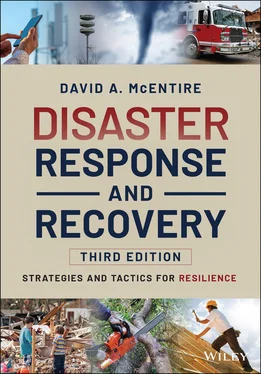David A. McEntire - Disaster Response and Recovery
Здесь есть возможность читать онлайн «David A. McEntire - Disaster Response and Recovery» — ознакомительный отрывок электронной книги совершенно бесплатно, а после прочтения отрывка купить полную версию. В некоторых случаях можно слушать аудио, скачать через торрент в формате fb2 и присутствует краткое содержание. Жанр: unrecognised, на английском языке. Описание произведения, (предисловие) а так же отзывы посетителей доступны на портале библиотеки ЛибКат.
- Название:Disaster Response and Recovery
- Автор:
- Жанр:
- Год:неизвестен
- ISBN:нет данных
- Рейтинг книги:5 / 5. Голосов: 1
-
Избранное:Добавить в избранное
- Отзывы:
-
Ваша оценка:
- 100
- 1
- 2
- 3
- 4
- 5
Disaster Response and Recovery: краткое содержание, описание и аннотация
Предлагаем к чтению аннотацию, описание, краткое содержание или предисловие (зависит от того, что написал сам автор книги «Disaster Response and Recovery»). Если вы не нашли необходимую информацию о книге — напишите в комментариях, мы постараемся отыскать её.
The new edition of the standard textbook in the field, updated with new studies and practical guidelines for reacting to the complexities of today’s disasters Disaster Response and Recovery: Strategies and Tactics for Resilience
Disaster Response and Recovery: Strategies and Tactics for Resilience, Third Edition
Disaster Response and Recovery — читать онлайн ознакомительный отрывок
Ниже представлен текст книги, разбитый по страницам. Система сохранения места последней прочитанной страницы, позволяет с удобством читать онлайн бесплатно книгу «Disaster Response and Recovery», без необходимости каждый раз заново искать на чём Вы остановились. Поставьте закладку, и сможете в любой момент перейти на страницу, на которой закончили чтение.
Интервал:
Закладка:
Normalcy‐generated demands are the pressures to quickly get things back to pre‐disaster conditions. Returning people to their homes and restarting business activity are types of normalcy‐generated demands.
Mitigation‐generated demands are the desires to prevent a recurrence of the disaster. Creating more stringent building codes and relocating residences to less‐hazardous areas are examples of mitigation‐generated demands.
Preparedness‐generated demands are expectations that the mistakes made evident in response and recovery operations will not be repeated in the future. Improvements in planning, training, exercises, and the allocation of additional resources fall into this category.
All of these disaster‐related demands create priority problems for emergency managers. Normalcy‐generated demands sometimes run in opposition to the mitigation and preparedness‐generated demands. As an example, people wish to return to their homes even when it would be best to remove them permanently from the floodplain. Government officials may also desire to give attention to rebuilding schools rather than invest in emergency management personnel or planning activities. Too much attention on preparedness could limit necessary actions related to mitigation. In spite of these conflicts and challenges, you must take advantage of the increased public concern disasters provide to promote change during response and recovery. All of these immediate objectives and long‐term functional activities should be directed toward the goals of disaster resilience. Resiliencemay be described as the ability to react effectively and efficiently in time of disaster. It is the overarching goal of the remainder of this book.
Self‐Check
Do hazards interact with each other?
What do we call hazards that occur in conjunction with other hazards?
How are disasters different from hazards?
What changes occur in society after a disaster?
Why are response and recovery operations needed?
What demands do emergency managers face after a disaster?
SUMMARY
As an emergency manager, you should be aware of important concepts such as hazards, vulnerability, disasters, emergency management, response, recovery and resilience. You must understand what types of hazards may occur including their natural, technological, and civil/conflict variants. It is also imperative that you comprehend how hazards interact with each other and vulnerability as well as how a myriad of variables may determine the impact of disasters. Successful emergency managers should know what changes to expect when a disaster occurs. They must effectively meet the demands that confront them and deal with the aftermath of a disaster in a proactive but adaptable manner.
KEY TERMS
| Agent‐generated demands | The needs made evident by the hazard (e.g., problems resulting from the disaster agent itself). |
| Atmospheric hazards | A hazard agent that is produced in or by the earth’s atmosphere. |
| Biological hazards | Agents that spread disease or are otherwise harmful to life. |
| Civil/conflict hazards | Hazards resulting from panic flight, riots, mass shootings, terrorism and war. |
| Compound hazards | Multiple hazards that react to each other in chaotic fashion. |
| Disasters | Deadly, destructive, and disruptive events that occur when a hazard (or multiple hazards) interacts with human vulnerability. |
| Emergency management | From an academic standpoint, “the study of how humans and their institutions deal with hazards, vulnerabilities and the events that result from their interaction.” From a practical perspective, “the managerial function charged with creating the framework within which communities reduce vulnerability to hazards and cope with disasters.” |
| Emergency managers | Public servants that help jurisdictions reduce the liabilities that lead to disasters. They also help built community disaster capabilities. |
| Enhanced Fujita Scale | A scale used to categorize the size of a tornado, including the affiliated wind speed. |
| Environmental hazards | Agents that involve the degradation of the environment, such as pollution, that pose a risk to people’s health and well‐being. |
| First responders | Public safety personnel such as police officers, fire‐fighters and emergency medical technicians. |
| Geologic hazards | Hazard agents associated with the earth’s soil and rock. |
| Hazard | A physical, technological, or intentional agent such as an earthquake, industrial explosion, or terrorist bombing. |
| Heat index | Incorporates both temperature and humidity into a scale to help warn people to stay inside and drink lots of water. |
| Homeland security | “A concerted national effort to prevent terrorist attacks within the United States, reduce America’s vulnerability to terrorism, and recover from and minimize the damage of attacks that do occur.” |
| Hydrologic hazards | Hazard agents that occur with the earth’s water systems. |
| Industrial hazards | Hazards produced by the extraction, creation, distribution, storage, use, and disposal of chemicals. |
| Mercalli scale | A scale used to describe the physical observation of damages that result from the movement of the earth’s crust (e.g., broken windows, cracked walls, falling pictures, etc.) |
| Mitigation | Risk reduction, loss minimization, or the alleviation of potential negative impacts associated with disasters. |
| Mitigation‐generated demands | The desire to learn from the disaster and avoid making similar mistakes in the future. |
| Na‐tech hazards | A combination of natural–technological hazards. |
| Natural hazards | Those events originating from the physical environment, typically because of radiation from the sun, heat flow within the earth, or the force of gravity. |
| Normalcy‐generated demands | The pressures to get things back to pre‐disaster conditions. |
| Nuclear hazards | A hazard resulting from the presence of radioactive material. |
| Pathogens | Organisms that spread disease which may include anthrax, smallpox, plague, hemorrhagic fever, and rickettsia. |
| Preparedness | Efforts to increase readiness for disaster response and recovery operations. |
| Preparedness‐generateddemands | Expectations that the mistakes made evident in response and recovery will not be repeated in the future. Improvements in planning and the allocation of additional resources fall into this category. |
| Prevention | Refers to actions to stop the occurrence of terrorist attacks and includes the gathering of intelligence, counterterrorism operations, and border control functions. |
| Protection | Refers to actions that discourage attacks through increased security measures or effor to minimize damage if such attacks cannot be prevented in the first place. The reliance on guards, fences, video surveillance, and access control falls into this category. |
| Recovery | Activity to return the affected community to pre‐disaster or, preferably, improved conditions. |
| Richter scale | A measurement of the registered shaking amplitudes of an earthquake. |
| Resilience | The ability to react effectively and efficiently in time of disaster. |
| Response | Activity in the immediate aftermath of a disaster to protect life and property. |
| Response‐generated demands | The needs that are made evident as individuals, organizations, and communities attempt to meet agent‐generated demands. |
| Riots | Large disturbances where people engage in antisocial behavior. |
| Saffir–Simpson scale | A descriptive tool to explain the magnitude of a hurricane in terms of wind and storm surge. |
| Seismic hazards | Hazard agents produced by the movement of tectonic plates that float on magma. |
| straight‐line winds | strong winds that travel down to the ground and then move horizontally along the earth’s surface. |
| Structural collapse hazards | Hazards that occur when gravity and poor engineering result in the failure of buildings, roads, or other construction projects. |
| Technological hazards | Hazard agents related to industry, structures, hazardous materials, computers, and transportation systems. |
| Terrorism | The threat or use of violence to intimidate someone or a government. |
| Toxins | Poisons created by plants and animals. |
| Transportation hazards | An accident that occurs in the air, on roads or railways, or at sea. |
| Vulnerability | Proneness to disasters or the inability of individuals, organizations, and communities to prevent them or deal with them effectively. |
| Wildfire hazards | Hazards that result from lightning strikes, which can quickly envelop hundreds of acres of forest and brush. |
ASSESS YOUR UNDERSTANDING
Интервал:
Закладка:
Похожие книги на «Disaster Response and Recovery»
Представляем Вашему вниманию похожие книги на «Disaster Response and Recovery» списком для выбора. Мы отобрали схожую по названию и смыслу литературу в надежде предоставить читателям больше вариантов отыскать новые, интересные, ещё непрочитанные произведения.
Обсуждение, отзывы о книге «Disaster Response and Recovery» и просто собственные мнения читателей. Оставьте ваши комментарии, напишите, что Вы думаете о произведении, его смысле или главных героях. Укажите что конкретно понравилось, а что нет, и почему Вы так считаете.












